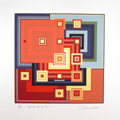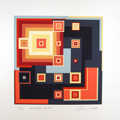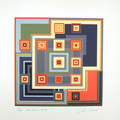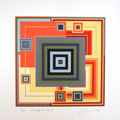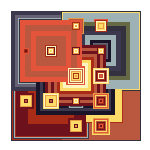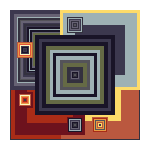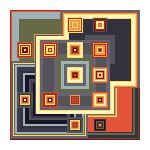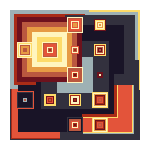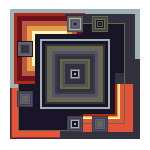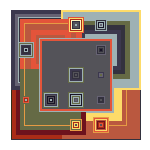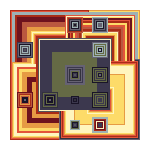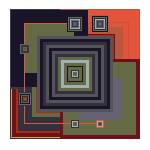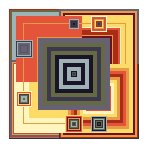Exploration in Warm and Cool Colors WC68-69 series of museum quality digital prints on paper is available now. Each edition is limited to 10 prints, when an edition is sold out there will be no more of that edition printed ever. All prints are printed on heavy weight archival watercolor paper with archival pigment ink. Each print is hand signed and editioned by Don Relyea in pencil and comes with a certificate of authenticity also hand signed by the artist. All prints are on 13" x 19" heavy weight water color paper with image area about 10"x10" suitable for framing. Prices are available upon request please email me. I am accepting orders now.
WC68-69 limited edition series below all available on 13x19 heavyweight water color paper.
Please allow a week or so for printing and shipping. If you need a rush order for a gift please email me and we can make arrangements. Colors on the actual print may differ very very slightly from the thumbnails based on differences in color calibration from computer monitor to monitor.
Exploration in Warm and Cool Colors WC68-69 series was created in a customized version of my space filling curve abstract art generator. It is worthwhile to note that the overal designs and color themes of this series were generated by a computer program coded by the artist.
There are nine total images in this series. However, the numbers do not go from 1 to 9. There were 14 total images generated only 9 made the final cut.
Abstract:
WC68-69 Series is created using a version of my space filling curve art generator that is tailored for capturing very small sections of the curve and enlarging them thousands of times. This version of the program employs both fractal and generative processes in the creation of the images.
Statement:
I write my own custom software applications to create generative art and video. I have spent some time mildly obsessed with infinite dimensional Euclidean space, also known as Hilbert space.
The WC68-69 series was created in a customized version of my space filling curve abstract art generator. The original "Exploration of Related Points on a Space Filling Curve" was created in an application written in Director and C++. The main program algorithm is based on the Hilbert space filling curve, discovered by mathematician David Hilbert in the early 1900's. The program recursively draws rectangles along the curve, storing special points in a lookup table. At certain times during the execution it draws larger concentric rectangles and connects the stored special points with trailed concentric rectangles. The program accesses a color theory algorithm that manages the colors used during program execution. The program can generate these images with relative ease, much easier than I could by hand. This later version is tailored for capturing very small sections of the curve and enlarging them thousands of times. The program employs both fractal and generative processes in the creation of the images.
The space filling curve art generator began as a lot of computational art projects usually do, with the objective of pushing the boundaries of the cpu, image size and resolution. After some time I was able to produce very large very detailed complex renderings of these space filling curve designs. It was not until after I began collaborating with a west coast abstract/minimalist painter ( Chris Ashley ) on another software art project (the reductionizer) that observed the nice designs happening at the microscopic level of the work.
Technical Brief:
A custom application was created in Adobe Director and C++ to render this image. The algorithm is based on the Hilbert space filling curve. The program recursively draws rectangles along the curve. At certain times during the execution it draws larger concentric rectangles and connects special points along the curve with trailed concentric rectangles.
Included is the main source code below so one can see the code manifestation of the mathematics behind this work. (lingo condensed from the Adobe Shockwave version):
on hilbert_draw(x0, y0, xis, xjs, yis, yjs, n)
--/* n=number of recursions*/
--/* numsteps= number of drawing iterations between two points on the curve*/
--/* x0 and y0 are coordinates of bottom left corner */
--/* xis & xjs are the i & j components of unit x vector */
--/* similarly yis and yjs */
repeat while n > 0
hilbert_draw(x0, y0, yis/2, yjs/2, xis/2, xjs/2, n-1)
draw_from_to_numsteps( point(x0+xis/2, y0+xjs/2), point(x0+(xis+yis)/2, y0+(xjs+yjs)/2), numsteps)
hilbert_draw(x0+xis/2, y0+xjs/2 ,xis/2, xjs/2, yis/2, yjs/2, n-1)
draw_from_to_numsteps( point(x0+xis/2, y0+xjs/2), point(x0+(xis+yis)/2, y0+(xjs+yjs)/2), numsteps)
hilbert_draw(x0+xis/2+yis/2, y0+(xjs/2)+(yjs/2), xis/2, xjs/2, yis/2, yjs/2,n-1)
draw_from_to_numsteps( point(x0+(xis/2)+(yis/2), y0+(xjs/2)+(yjs/2)), point(x0+(xis+yis)/2, y0+(xjs+yjs)/2), numsteps)
hilbert_draw(x0+(xis/2)+yis, y0+(xjs/2)+yjs, -yis/2,-yjs/2, -xis/2, -xjs/2,n-1)
draw_from_to_numsteps( point(x0+xis/2+yis, y0+xjs/2+yjs), point(x0+(xis+yis)/2, y0+(xjs+yjs)/2), numsteps)
n=n-1
if n=0 then exit repeat
end repeat
end
